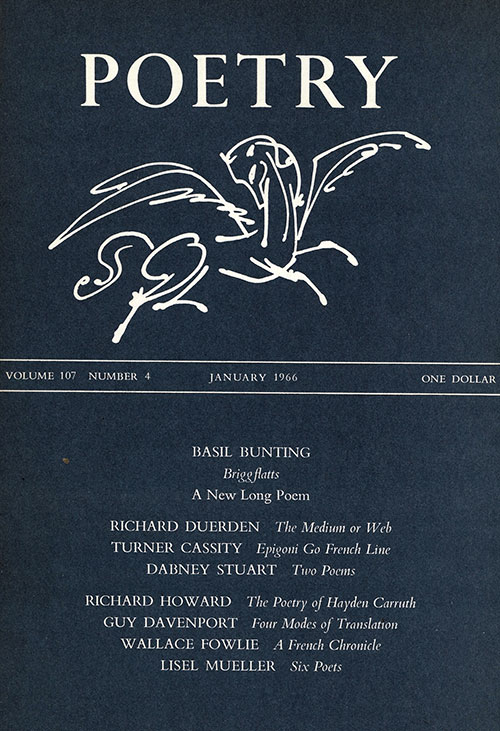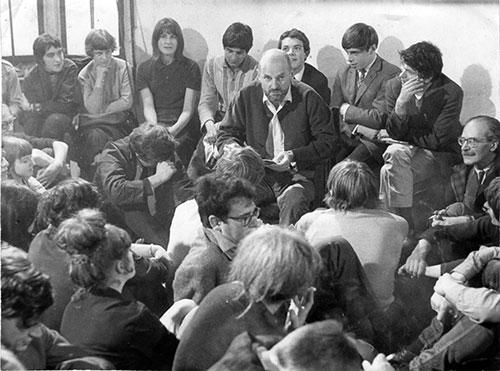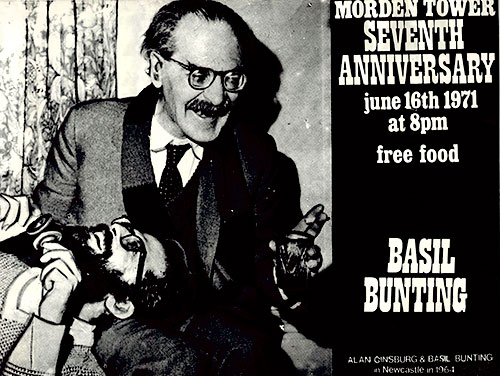'To Show Me How It Was Done': On the Fiftieth Anniversary of Briggflatts
BY Tom Pickard
Fifty years ago this month, Poetry published Basil Bunting’s Briggflatts. In honor of the occasion, Tom Pickard wrote this recollection of Bunting, Briggflatts, and the Morden Tower. You can read the poem as it was originally published in our archive.

Briggflatts was first performed in public at the Morden Tower, on December 22, 1965, where my then-partner, Connie, and I had built a regular audience for poetry readings and events over the preceding eighteen months. The reading of Briggflatts was to be Basil Bunting’s second gig there. We’d met in 1964 and he greatly encouraged our endeavors at the Tower and perhaps even legitimized them.
Up to that point I’d say Bunting viewed the visible English literary landscape as unwelcoming, staid, cynical, pleased with itself and reactionary, much like post imperial Britain. What the Morden Tower brought him and us was an expanse of possibilities and a will to do it ourselves without seeking permission. We were revolving around our own omphalos, as Roy Fisher puts it in his poem, “Talking to Camera”:
There’s no shame
in letting the world pivot
on your own patch. That’s all a centre’s for.
Anything else is politics.
The Morden Tower is situated halfway along an unlit alley, Back Stowell Street, on the western portion of the thirteenth century wall that once protected the city of Newcastle upon Tyne from invading Scots. It also served to garrison troops who would, when required, invade our neighbors. This surviving piece of the wall backed onto a very narrow unlit ally along which small industrial workshops operated, emitting sulphurous fumes. As a school boy I had climbed onto the wall a number of times to hide out whilst playing truant with friends equally in awe of the city’s secret history. And, because refuse was often strewn along the narrow lane and it was used by people who wanted to be out of sight for reason of forbidden sex, mugging, illicit commerce, or to take a piss, you had a sense of its usage over centuries unchanged. Attending a Tower gig on a winter night took a little courage, stepping into the darkness in the hope that you would not (or might) be molested on the way. Fortunately, courage was available by the pint in the Northumberland Arms at the end of the lane and we took our fill before the event, during the interval, and afterwards. The only other arts venue in the city that generated a frisson of fear as you approached was The Downbeat, situated in a near derelict warehouse where Eric Burdon, Alan Price, and other Geordie blues artists got started, and where violence was a jumpy neighbor.

In 1963, living with Connie and our baby in the first of a few homeless episodes, we read an article about a small publisher based in Lowestoft, Norfolk: The Scorpion Press. When we decided that I should hitchhike the 300 miles to offer him a bunch of my own efforts, one of the first people to stop and give me a lift was a man named Ian Wood, a filmmaker working for the National Coal Board documentary unit. When I told him that we were trying to run an old tower as a bookshop and performances venue he gave me the contact details of his friend, the poet Pete Brown, whom he knew from jazz and poetry gigs. Brown became the first poet to perform in the tower and later went on to write most of the lyrics for Cream with Jack Bruce.
When I got to Lowestoft the publisher was uninterested in my poems but showed me the City Lights Books that he was distributing in the UK and gave me the first couple of issues of the New York based magazine Kultur, where there was an advertisement for William Burroughs’s “Exterminator” published by Jargon Press in North Carolina. I wrote a semi-literate letter to the publisher requesting copies. Some weeks later I received a friendly reply from Jonathan Williams who told me that he’d recently been in North East England while on a walking tour of the Pennines with his partner, the poet Ronald Johnson, and he gave me the contact details of folks he’d met in Newcastle—including Bunting. Shortly after receiving the letter I made contact with Basil and he came to the Tower’s first gig on Blooms Day (June 16) 1964, and a few weeks later, reading “Chomei at Toyama” and “The Spoils,” gave the second one himself. David Sweetman, then a student in the Fine Art Department, designed and silk-screened a poster for the Pete Brown event that I distributed in the windows of shops and bars around the town.
Later that same year I hitchhiked to the Edinburgh festival where I met Michael Shayer who was co-publisher with Gael Turnbull of Migrant Press. They were issuing primitively printed chapbooks by Edward Dorn, Charles Olson, Cid Corman, and Roy Fisher, amongst others, and were part of a UK network of little presses working independently of each other but with an interest in “alternative” poetries, if there is such a thing—perhaps more accurately, they were open to the wide range of poetries.
By 1965 I was an unemployed laborer in dispute with dole authorities who threatened prison for failing to maintain my family. Connie was an out-of-work teacher—sacked because she was adulterously living with a guy only a year or so older than her sixth form pupils, and there’d been mention of it in the local newspapers when they ran occasional articles on the Morden Tower.
We were hiring the building from the city council for a rent of 10 shilling a month, paid quarterly. It had no running water or toilet facilities and no electricity. Our first idea was to start a bookshop with international avant-garde writing and small press publications along with anarchist, leftist, ecology pamphlets, underground newspapers, and magazines. Alternative everything—basically a counter-culture outlet and information center supplying the kind of work otherwise unavailable, on what was left of Connie’s severance pay and her cashed-in superannuation. We were also showing work by locally based artists. Musicians, such as Alan Hull, performed there. When we tried to stock books, on a sale or return basis, from establishment publishers, their reps, with the exception of John Calder’s, told us that the venue was better suited to breeding pigeons than selling books. This attitude echoed the response from the arts bureaucracies when we applied for financial assistance to keep the place going.
In those days, the University of Newcastle was a creative environment (actually it was Kings College—an outreach of Durham University) and some remarkable talents were studying and working. From the English department, Claude Rawson became an ally as did Connie’s friend, “the father of Pop Art,” Richard Hamilton, who was teaching fine art. When we published Bunting’s The Spoils in 1965, Hamilton went through Basil’s scrapbook and photograph albums and chose the picture for the cover of the pamphlet and much else for the loose-leaf magazine devoted to Bunting, King Ida’s Watch Chain. Hamilton designed and oversaw the publications. Along with Bunting and a couple of other good-natured and far-seeing people they became the Morden Tower “committee”—something anathema to our anarchistic ethos. However, they were honorable people who lent their names and their energy to help us negotiate an arts bureaucracy that, in turn, found Connie and I anathema to their moral and aesthetic standards. In shorthand, we were the “undeserving poor,” and the concept of an indigenous democratic arts environment hadn’t filtered through to the civic dignitaries or the newly formed North Eastern Association for the Arts, even though the latter had been formed by enlightened socialist politicians. In the mid-sixties they thought that art had to be imported and administered by, to be blunt, “toffs”—an Imperialist mind-set that prevails. Art is meant to be dispensed like hand wash in a bathroom to grubby consumers. You can see something of this in Bunting’s “What the Chairman Told Tom,” which I’d argue was as much about “Basil” as it was about “Tom.” That poem should be read as an echo of his 1929 ode, “An Arles, an arles for my hiring,” where
The Lady asked the Poet:
Why do you wear your raincoat in the drawing-room?
He answered: Not to show
my arse sticking out of my trousers.

Robert Creeley was our third reader and he documents that first meeting with Bunting variously. At Claude Rawson’s suggestion we invited Edwin Morgan from Scotland for the next gig. Basil was anxious to bring Hugh MacDiarmid and when Hamish Henderson followed him that cemented our contacts with Scotland, where we looked rather more so than to London for intellectual fellowship and solidarity. But there is a north in every southern town and London hosted amongst others Stuart and Deidre Montgomery’s Fulcrum Press, which was to publish Briggflatts. So we connected to what was clearly a network of like-minded groups spread over UK, publishing writing and thinking well outside of the “canon.” Michael Shayer once drew me a map of such dispersed but associated cells. What the tower did was to create an audience which was the sixties in microcosm, a space where artists experimented across disciplines and where an audience came together across a rigid class structure. I take it as read that artist and audience are sometimes interchangeable. Bunting delights in the audience’s “delinquent” mix in a number of letters to friends. The shape of the room forbids a lectern and demands an intimacy of audience and performer.
As Bunting composed Briggflatts in 1965 we would meet a few times a week for a lunchtime pint on his break from work, or back at our home with Connie. On those occasions he’d take out his notebook and read the poem so far, or just the new lines being knit into shape. Not a great deal of that notebook ended up in the poem, but it was where he was working his way through it. He appeared to be weaving his life, lived and observed, into a pattern of sound and sense, place and time. He says somewhere that he wrote Briggflatts to show me how it was done. But I’m sure the Morden Tower audience and ambiance triggered his “muse.” It gave him and other writers a sense of belonging, a place and a society, even if that society was a society of misfits from all backgrounds.
And the way Briggflatts and Bunting permeated and inspired across disciplines is perfectly shown in Mark Knopfler’s “Basil,” a song on his recent album, Tracker. Knopfler, who knew Bunting when they both worked in the local newspaper office in the mid-sixties, meditates on time—over a similar period that Briggflatts covers.
Naturally sixties culture didn’t just come out of nowhere, nothing ever does. The precedents were there; just as rock and roll artists honored their blues masters and new forms and energies were forged, those of us in poetry who sought new vehicles for our voices found Bunting and his generation of mold breakers never far from song. In an England of metronomic obedience, Bunting, David Jones, MacDiarmid, Lorine Niedecker, William Carlos Williams, Olson, Pound, and others offered a measure by ear and breath—the invention of form rather than a blind obedience to it “before the rules made poetry a pedants game.”
Literary England was hostile to what threatened its mediocracy and grip on power. Bunting had no place in it, was an exile from it, as was the generation growing up in the sixties, outside of the academy and privilege, who were seen as the barbarians at the gates. When those forces found each other great work was produced and Briggflatts one of the greatest.

Event celebrating the fiftieth anniversary of the publication of Briggflatts:
As a way of honoring the poem and marking its making (and first publication in 1966) a small group has formed to organize a celebration from 24-26 of June 2016.
The timing of the event is close to the opening reading in the Morden Tower, Blooms Day (June 16) 1964, and will also serve to celebrate the work accomplished in the Morden Tower over that time. There will be talks, discussions, readings and music, film, and an exhibition of posters and photographs in a few venues, but primarily in the Morden Tower and The Mining Institute. We often used the Mining Institute when the tower was out of action through vandalism, so the venue has a history of association and an excellent performance space.
The universities of Durham, Newcastle, and Northumbria are collaborating in the events and participants so far agreed are Iain Sinclair, Claude Rawson, Colin Simms, August Kleinzahler (a former student of Bunting), Banjo Billy Lloyd, Keith Wrightson, Richard Burton (biographer), Don Share (editor of the forthcoming Bunting collected), Alex Niven (editor of Bunting’s letters), Stuart and Deidre Montgomery (Bunting’s first UK publishers), and a range of others. For updated information click here.
Tom Pickard was born in Newcastle, England, and left conventional schooling at the age of 14. His collections...
Read Full Biography

